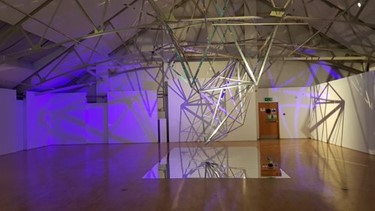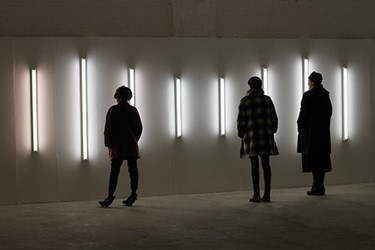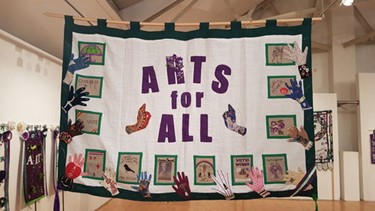3 – 29 August 2018
This exhibition is part of the first Linen Biennale Northern Ireland, a celebration of the past, present and future of Europe’s oldest textile.
Featuring artists: Christine Mauersberger, Mylène Boisvert, Sandra Turley, Damian Magee and Jill Phillips.
Mylène Boisvert
1. Col #4 – 2017
Col #4 is part of The Linen Seasons a collection of works made from textile paper, primarily linen, loosely inspired by antique lace. Kilometres of paper thread painstakingly produced by hand using a Japanese technique called kami-ito are used to create works installed on bases and hung on walls.
I like the idea that the flax fibre I use was originally a fabric that was subsequently turned into paper, which I once again transform into thread. I then use that thread to construct large works. The designs are drawn on my studio wall using linen paper just like I would do with a marker. Some of the works also incorporate papers made from abaca, cotton or Japanese mulberry as well as flax fibre. Taking my inspiration from the rich history of textiles, I create textile constructions based on a personalized language and gestural expression.
Sandra Turley
2. Weavers – 2018
3. Spinners and Doffers – 1998
Sandra Turley is a textile artist specialising in printed textiles, book art and site-specific installations. Her work frequently addresses issues of place, community and identity. By working to a particular theme her work progresses through numerous pathways, experiments, academic research and processes. “For me the journey must always be exciting and not limited by end results so that the element of chance and accidental discoveries keeps work alive”
Weavers is a reflection on women’s work. I had been drawn to a large, handwritten ledger (1927/28) held in Craigavon Museum Services containing the names of weavers, both men and women. The names appear relentlessly repeated over the weeks with female weavers’ names written in red ink. With red thread I trace the journey of the pen across the page and reflect upon the passage of time. As I study each name not only do I think of this woman and her work but also the male clerk who documented and calculated the wages. As I work, the newsreader reminds me that it is fifty years since the Ford sewing machinists went on strike in Dagenham.
Spinners and Doffers. Artist’s book containing the memories of millworkers in 1998 and images of Gilford Mill.
Christine Mauersberger
4. The Plastic Holds No Water – 2017
This work was made as a result of my concern about plastic pollution found in our oceans. Most of this trash cannot be seen because it is so tiny that it is invisible to the human eye but is floating just beneath the water’s surface. Marine wildlife ingests these plastics and its effects are long lasting and deadly. It is my intention to help to bring awareness to this threat.
To make this installation, I hand-dyed linen using indigo, then cut and machine-sewn it onto a base of tulle to create work that looks like a vista of water, upon closer inspection, one can see pieces of plastic.
Damian Magee
5. Weaving Record (with Punch) – 2018
The technologically sophisticated early hand looms utilised punch card for translating designs into binary code, making them proto-computers. In the 1960’s magnetic tape gradually replaced punch cards as the primary medium for storing computer data. Today, only the last of the master weavers retain the historical knowledge and idiosyncratic computational and engineering skills required to operate these looms.
Working in collaboration with one of the only remaining master damask linen weavers in the island of Ireland, with unique access to a loom granted by the Irish Linen Centre, we endeavoured to weave cassette tape as a means to record the weaving process. The tape preserves its original function as a recording medium by existing as a document of its own transformation from line into form. Foregrounding the relationship between material, weaver and loom, all mechanical and gestural processes that embody the legacy of the linen industry disappear into the cloth. Meanwhile, the punched out card that formulate the zero’s or one’s of new linen designs continue to accrue as physical by-products. Fusing archaic mediums with similarly archaic technologies, complex historical narratives unfold through culturally encoded materials and industrial processes.
Jill Phillips
6. Different Buses – 2009
Going to school in Northern Ireland meant taking a different bus to my catholic neighbours. Like many in my generation I have steered away from anything political due to an inherent discomfort with our shared situation. Using imagery to transform a selection of bus seats into something new giving us a visual imagery that we are one. Screen-printed and laser-etched on natural linen the work uses colour to confuse and unbrand each school, to twist things up and allowing them to become more united.
7. Niamh – 2009
8. Caoimhe – 2009 (8)
9. Keela – 2009 (9)
Exploring the strength and importance of our botanical plant life compared to the fragility of the natural system and the individual plant cycle. Using the delicacy and flow of botanical form as an influence; combining them with the rigidity and strength of the internal system of the plants, the final piece aims to display these juxtapositions through geometry, texture and colour. The imagery encourages the evolving play between the rigidity of geometry and the delicate nature of plant form. Organic geometry initially does not allow us to think of beauty and form, initially we think we will loose the delicate form, colour and visual exquisiteness of the imagery. Utilizing the combination of linen fabric elegantly embellished with embroidery completing the piece with a precision application of laser cutting expressing the fragility. Appreciating the balance, which subtly exists reflecting the exploration of our botanical eco system.




